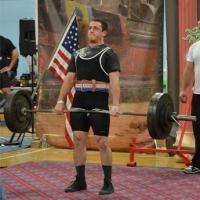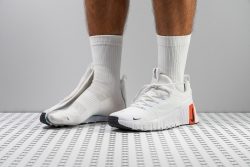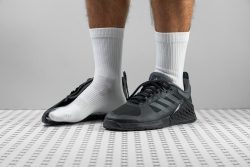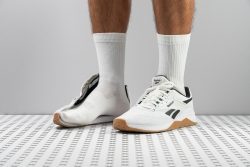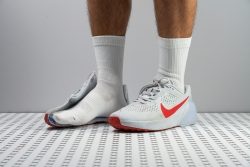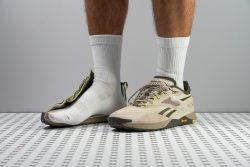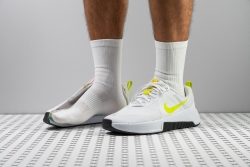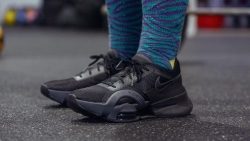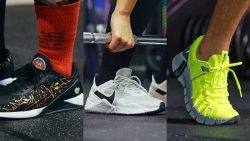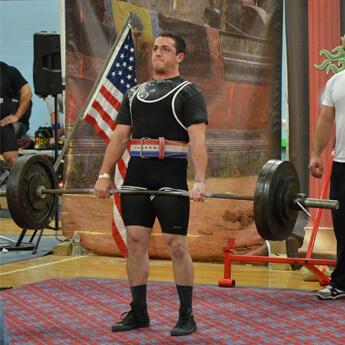7 Best Hiit Shoes
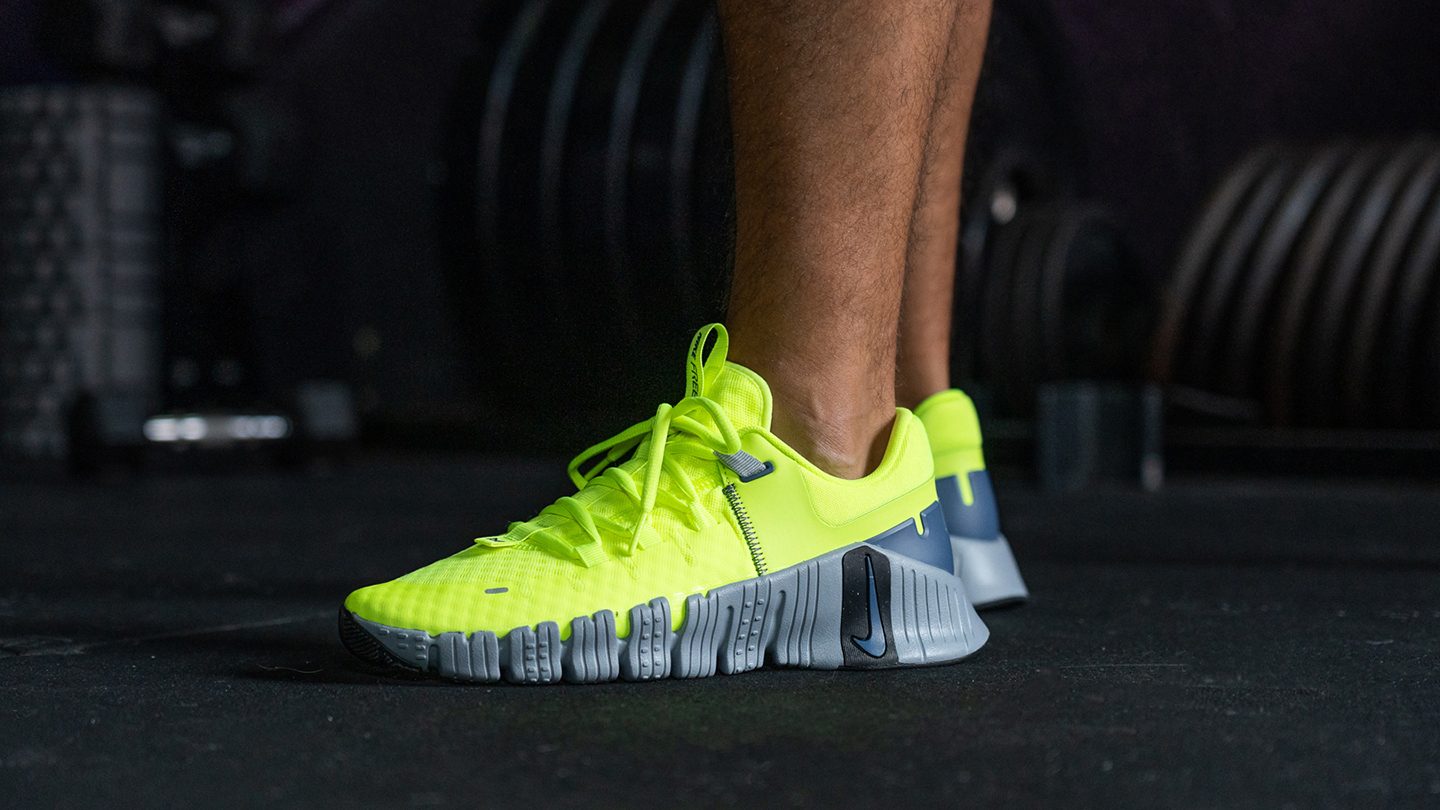
We buy shoes ourselves. We earn commissions when you buy through us, at no extra cost. Why trust us
High-intensity interval training isn't for the faint-hearted. It's truly high-intensity, and you will surely sweat it out. To do well in this programme, you need the support of good training shoes that are attuned to the unique demands of HIIT.
Of course, brands like Nike, Adidas, Reebok, and Under Armour would like you to believe that their offers are versatile enough to support the many types of exercises in a HIIT programme. They may be telling the truth. But we want you to be sure, so we present our top HIIT shoe picks.
We scrutinised every inch of these shoes to see which one is the number one. We didn't leave any details, may they be big or small. After testing the shoes in the gym and running tests on them in the lab, we then reviewed and evaluated which category they fit the most and excelled at the best.
How we test training shoes
A HIIT programme is composed of different types of exercises. We have to go through it to fully assess the versatility and durability of each shoe that we review. Our claims are all based on our personal experience in the gym.
Aside from making sure that we test the shoe during our HIIT workouts, we also do the following to ensure the validity and reliability of our reviews:
- Remain bias-free by buying the shoes using our own money.
- Strive for comprehensiveness by taking into account the science behind every shoe. We slice the shoes in half in our lab and we measure their stiffness, softness, outsole hardness, breathability, and all the other features that proved to be relevant for HIIT enthusiasts.
Best HIIT shoes overall
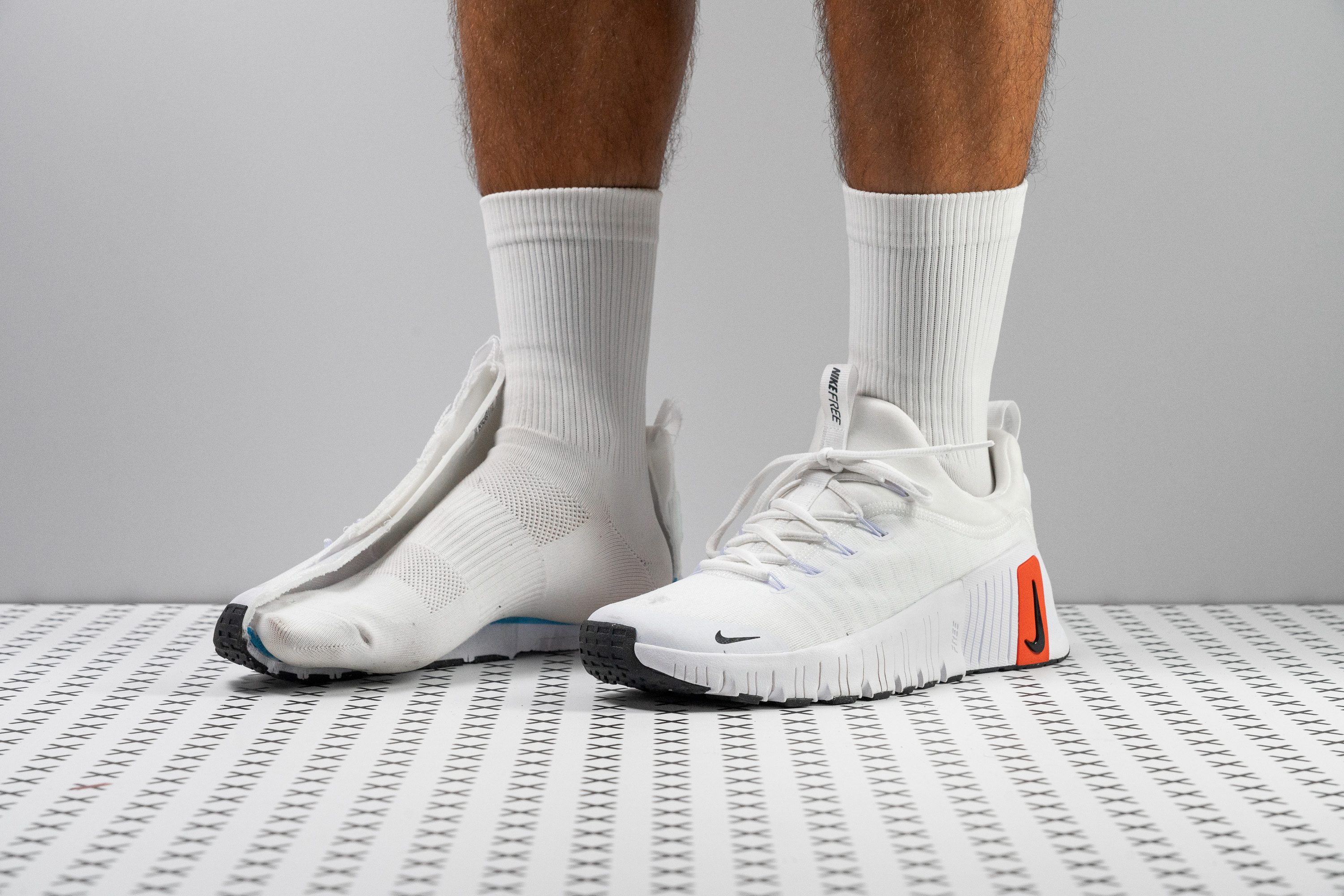

















































What makes it the best?
The Nike Free Metcon 6 reigns the HIIT category with its superior combination of flexibility and stability in our lab and exercise trials. Its airy design makes every movement effortless, while its unwavering support ensures confidence and sure-footedness.
The adaptive midsole, enhanced by deep outsole cutouts, bends with our feet easily and requires 76.9% less force than average to reach 90 degrees in our flex test. This is the lowest requirement we’ve ever seen so far, highlighting the shoe’s unmatched flexibility! Furthermore, it earned a low 2/5 torsional rigidity score in our assessment, meaning it twists with minimal resistance.
Featuring a balanced mix of cushioning and ground connection, the shoe’s velvet foam is 17.9% softer than average per our durometer. The extended midsole width of 113.9/94.4 mm and firmer 27.8 HA foam under the heel offer exceptional support for lateral movements and quick movement changes. Even as we lift weights, we never have the feeling of toppling over.
Amazingly, this whole package is only a mere 9.7 oz (274g) vs. the average 10.8 oz (306g) trainer. FM6 never burdened us with its weight and even kept heated sessions breezy with its seamless ventilation. However, the upper’s delicate mesh is prone to abrasions. We recommend activities like rope climbing to prolong the shoe’s life.
Pros
- Fantastic breathability
- Very light on foot (lighter than average too)
- Better cushioned for HIIT
- Most flexible cross-trainer ever
- Excellent stability for moderate weightlifting
- Sock-like fit in a bootie upper
- Accommodating toebox (for medium feet)
- True to size
Cons
- NOT for rope climbs (lacks protection)
- Can be hard to put on (narrow opening)
HIIT shoes with the best stability
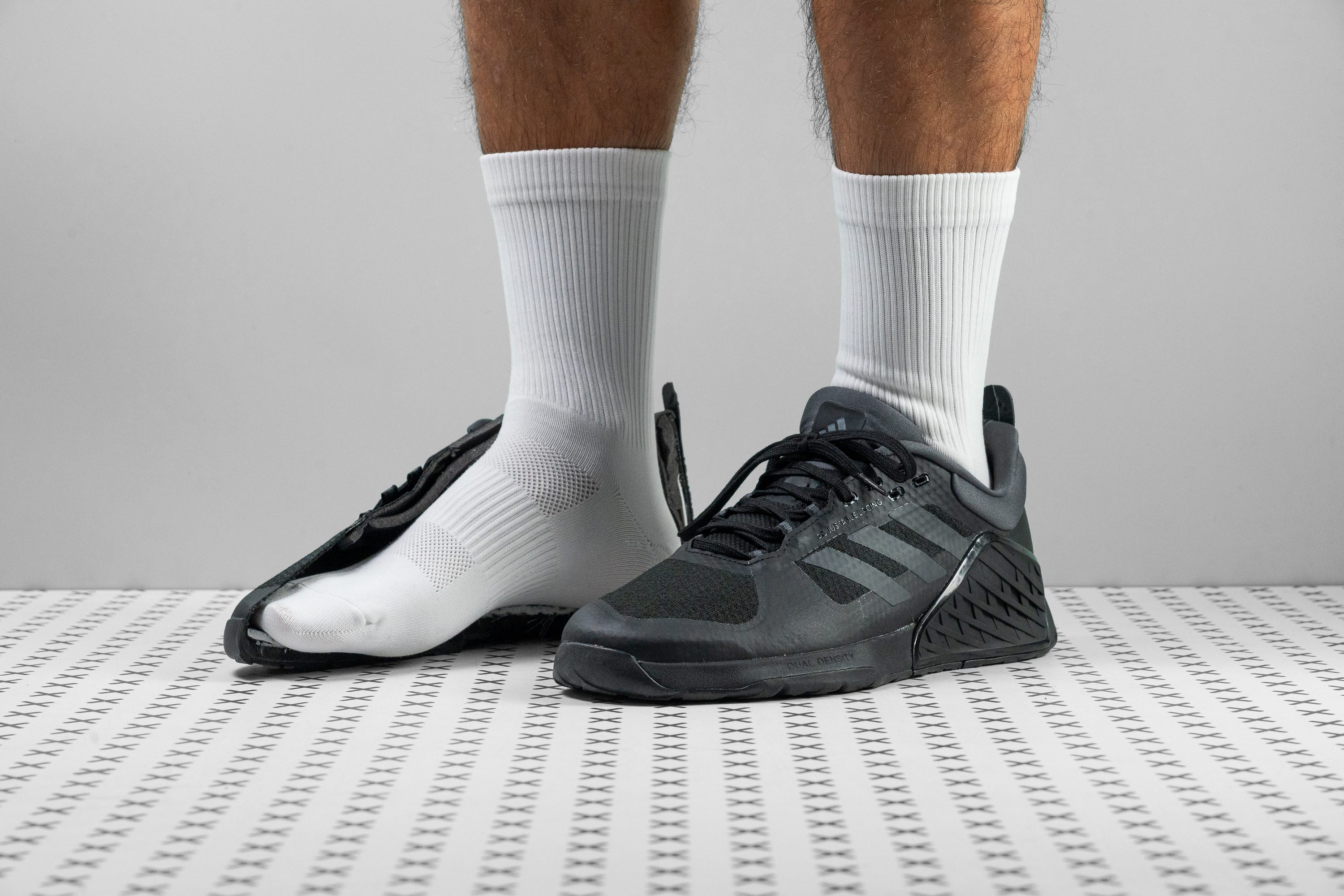














































What makes it the best?
Among the HIIT shoes we wore and lab-tested, Adidas Dropset 2 is the best stability trainer. It has an undeniably supportive structure featuring a firm heel, a wide and grounded platform, and a grippy outsole. We find it well-suited for lifting but also offers freedom and comfort for HIIT workouts by providing a lot of flex and out-of-this-world ventilation.
We feel surefooted with the vast and low platform. We received enough cushion for jumps and support for steady lifts. Dropset 2 features a dual-density foam. Our durometer shows it's a balanced 31.1 HA in the forefoot and a solid 47.0 HA in the heel. The latter is significantly 68.5% firmer than average. We felt its presence as it didn’t compress on our snatches and clean and jerks.
Offering exceptional ankle support are the TPU panels on the outer sides. Giving us extra control on lunges and lateral movements are the grippy outsole and flexible midsole. Our bend test confirms it’s 14.9% more adaptive than average.
It will be tough to find a trainer that’s more breathable than this. Featuring large ventilation holes and a rare Airflow Window hole in the sole, it releases our body heat and allows the breeze to flow in. It makes intense workouts in hot gyms more bearable.
Its 11.9 oz (336g) weight demands our attention, which is why it isn’t the best choice for quick and jumpy cardio sessions.
Pros
- Mindblowingly breathable
- Grounded and stable platform
- Flat base for weightlifting
- Comfortable in-shoe feel
- Reliable protection for rope climbs
- Surprisingly flexible forefoot
- Excellent grip on gym floors
- Gusseted tongue
Cons
- Mesh is easily destroyed
- Clunky for aerobics and treadmill
HIIT shoes with the best durability











































What makes it the best?
We consider this shoe as the most durable among all the HIIT shoes because several of its qualities were just geared toward lasting long. The outsole of the Reebok Nano X4 offered great resistance to abrasion, allowing us to use it without worry outdoors. Its upper delivered impressive durability. Also, the upper’s breathability kept our feet dry (thank goodness!) so we were able to continue with our workouts without ever feeling the need to change socks.
The outsole of the Nano X3 felt a bit firm. We subjected it to the usual Dremel test in the lab, and we were in awe that our assault left only 0.5 mm of damage, which was half that the typical outsole would have incurred.
Similarly, the upper displayed impressive resistance to abrasion. We had to give the Nano X4 a high score of 4 out of 5 for the durability of its upper.
It’s the upper’s breathability that completes the experience for us. We felt air going through the upper material quite easily. We confirmed this when we subjected the X4 to a smoke test and it got a score of 4 out of 5 when smoke pumped through the collar escaped quite easily through the toe box and sidewall materials.
It was just too unfortunate that the Reebok Nano X4 did not really suit gym rats with wide feet. The toe box is 99.4 mm, which is not any higher than the 99.9 mm average.
Pros
- Fantastic wear resistance
- Great balance of cushioning and stability
- Feels grounded and supportive
- Secure foot lockdown
- A fully-gusseted tongue (finally)
- Nice breathability
- Lighter than the X3
- Great grip on gym floors
Cons
- Not for heavy lifting
- Not for wide feet
Best HIIT shoes for speed

































What makes it the best?
The Nike Zoom Metcon Turbo 2 is our shoe of choice for cranking up the speed on our HIIT workouts, as its responsive and cushioned midsole, phenomenal flexibility and unbeatable breathability help us push the pace while performing our exercises.
We can't help but feel super fast while wearing the Nike Zoom Metcon Turbo 2, especially when doing exercises like jumps and sprints. Its responsive midsole, particularly the Zoom Air unit in the forefoot, adds a nice pop of energy to push us even farther. That midsole foam, which we measured to be 17% softer than the average training shoe, also offers excellent cushioning that keeps our feet well-protected during those speed-oriented exercises.
The Metcon Turbo 2 made just about every exercise we did on our HIIT workouts, from burpees to jumps to sled pushes, much more natural-feeling thanks to its exceptional flexibility. And indeed, our lab test proved how pliable the shoe is as it took 32% less force to bend it 90 degrees.
And perhaps the best thing about performing HIIT workouts in this shoe is that our feet barely get warm even after extended sessions. Its breathability is so good that we scored it a perfect 5 out of 5 in our lab test, as the smoke we pumped into it passed right through the upper with no trouble at all.
However, we don't recommend the shoe for those who go overly hard on their HIIT workouts. The Metcon Turbo 2 failed our toebox durability test - it got a lowly 1 out of 5 - as our Dremel wound up drilling a huge hole in the upper.
Pros
- Bouncy Zoom Air in the forefoot
- Good for short runs
- Perfect for jumps and aerobics
- Stable for moderate lifting
- Excellent flexibility
- Amazingly breathable
- Durable outsole
Cons
- Upper is not durable rope climbing
- Heavy for a "speed-oriented" trainer
HIIT shoes with the best energy return
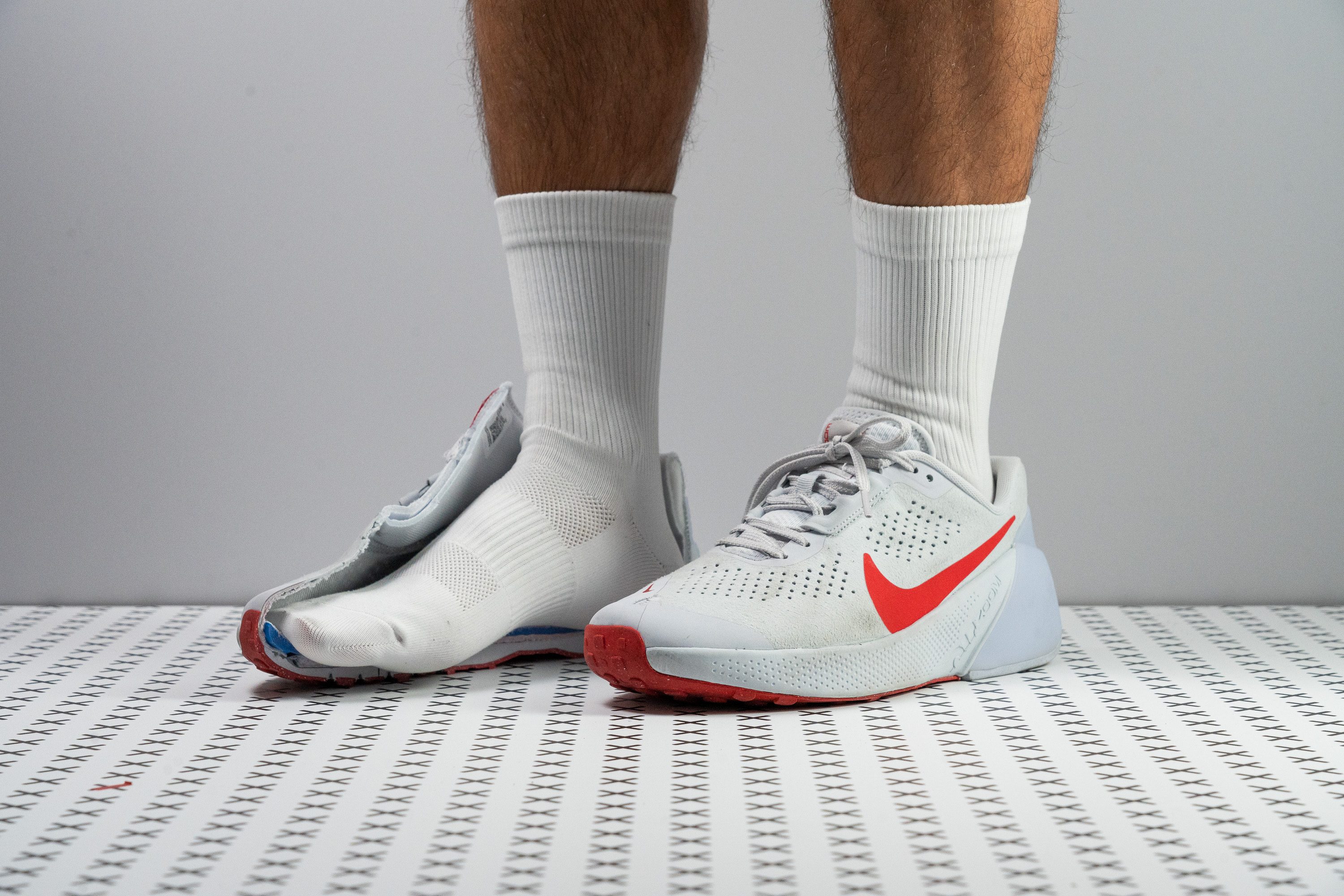











































What makes it the best?
The Nike Air Zoom TR 1 delivered the best energy return among HIIT shoes we worked out with and lab-tested. Its superior responsiveness enhances the efficiency of our jumps and footwork during intense workouts. Its bouncy yet cushioned feel, coupled with great traction, makes it an exceptional trainer for a wide range of activities.
When engaging in any workout landing on our feet, we immediately recognised the midsole’s responsive design. Inside, an Air Zoom unit contributes to the platform's consistent explosiveness, while the plush velvet cushion absorbs landing impact. Our durometer confirms our sensation as it emerged 24.6% softer than average.
The shoe's high level of flexibility keeps us agile as we bend our feet to lunges, burpees, and more. As demonstrated by our bend test, it surpasses the average trainer by 8.8% for a more effortless feel. Furthermore, the outsole's exceptional traction, evidenced by our confident performance in planks and mountain climbs, ensures stability and control during workouts.
However, its impermeable upper restricts airflow, making it suitable only for colder climates. Our breathability test indicates a low 1/5 score making it less ideal for athletes in warmer regions.
Pros
- Dependable bite on gym floors
- Pretty durable toebox
- Good impact protection
- Nice lateral stability
- Secure heel hold
- Smooth heel-to-toe transitions
- OK for occasional outdoor use
Cons
- Not breathable at all
- Not for heavy lifting
- Not for heavy lifting
Best HIIT shoes for outdoor workouts






































What makes it the best?
Doing HIIT exercises outdoors presents a lot of challenges to a shoe; good thing the Reebok Nano X3 Adventure is ready for all of them. Its firm outsole was able to resist minor scrapes. Its midsole felt softer than usual, and it allowed us to feel pampered all throughout our workouts. Finally, the shoe’s upper just felt sturdy and it protected us well from abrasion. Given all these benefits, we consider this Reebok shoe as the best for outdoors among all the HIIT shoes that we tried.
Using an HC durometer, we discovered that the outsole of this shoe has a rating of 89.4, which is higher than the 84.0 average. The firmness of the sole allowed it to resist punctures caused by pebbles and other debris that are commonly seen on outdoor surfaces.
The average midsole softness score is 27.2, but the Reebok Nano X3 Adventure was only rated 21.9 when we measured it using our HA durometer. The resulting softness allowed the midsole to absorb impact quite well.
Then there is the upper that got a perfect 5 for durability during our Dremel test. The shoe was able to hold its own even when colleagues accidentally stepped on our feet or when we unwittingly bumped our toes on exercise equipment.
We didn’t like that the Reebok Nano X3 Adventure was a bit on the heavier side. Weighing 12.45 oz or 453g, it was heavier than the 10.79 oz or 306g. The weight difference was enough to make us feel clunky.
Pros
- Perfect gym-to-trail shoe
- Dependable traction
- Provides good impact protection
- Offers enough court feel
- Super durable upper
- Just enough stability for exercises
- Feels light
- Fairly flexible structure
Cons
- Poor breathability
- Pricey if not used outdoors
Best budget HIIT shoes
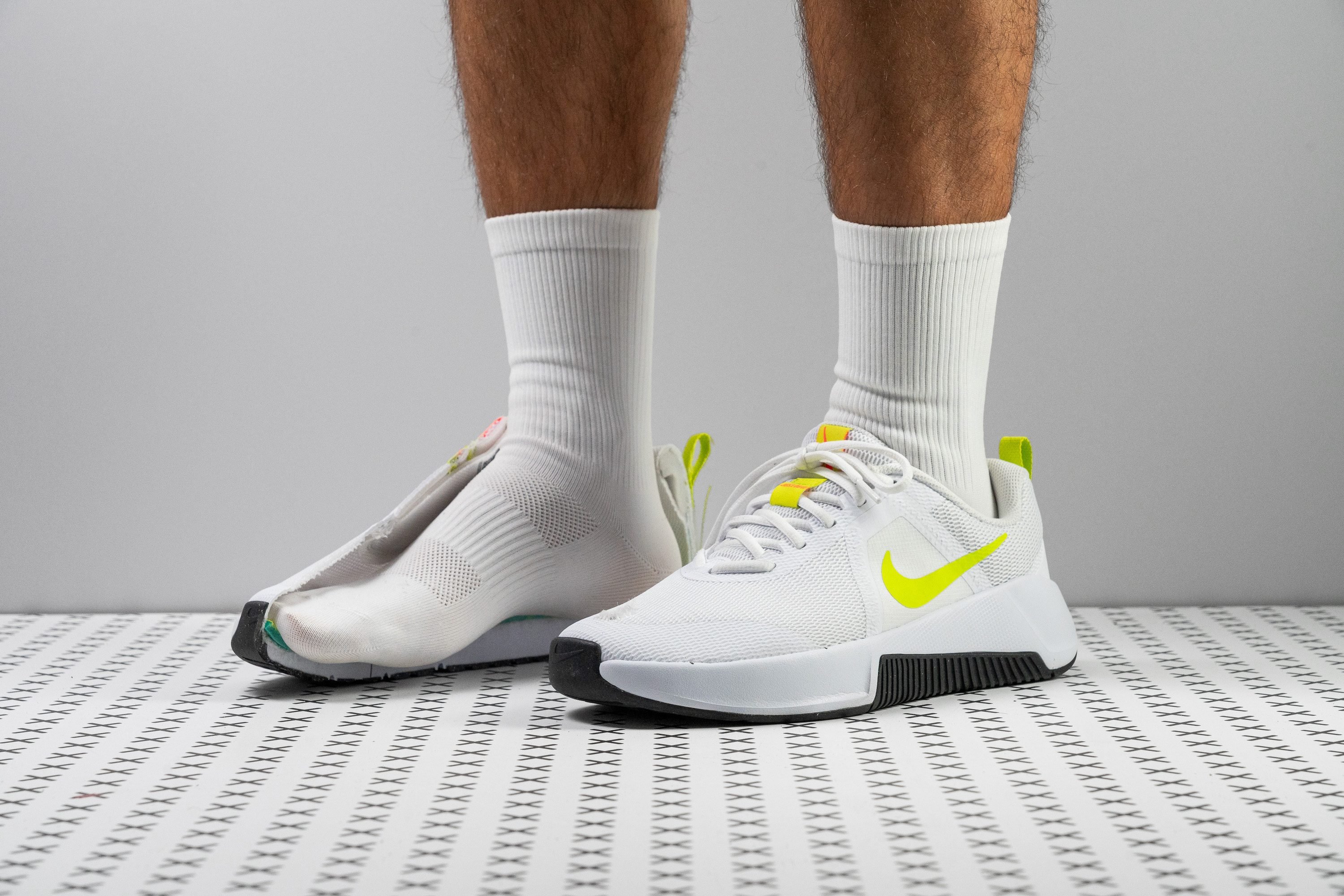














































What makes it the best?
The average HIIT trainer we’ve tested in the lab costs £110, but we got the Nike MC Trainer 3 for only £80, making it our best-budget HIIT trainer! Even with the price difference, this trainer did not cut back on comfort and performance at all. Its plush platform cushioned every landing while its breathable upper kept us refreshed.
Light in the pocket and on foot, our scales confirm MC Trainer 3 is a below-average 10.4 oz (296g). Its lightness, together with the flexible midsole, boosted our agility and speed for fast-paced workouts. Our bend test confirms it needs only 20.2N of force to reach a right angle.
With every jump or toe-off, a divine realm awaits. We measured the stack to be 30.6/21.8 mm, higher than the 24.7/18.4 mm average. Plus, the foam feels very pleasant to the touch, confirmed by our durometer to be 13.0% softer than average.
Even atop, the porous mesh upper delivered seamless ventilation. Our feet could breathe freely during the most heated sessions, evidenced by its perfect rating on our smoke test. Our transparency check reveals the upper’s delicate nature while our microscope shows countless ventilation holes. However, this made it more vulnerable to damage, as seen in the hole our Dremel left after testing. We recommend avoiding abrasive activities, such as rope climbing, while sporting this shoe.
Pros
- Fantastic value for money
- Highly breathable
- Doesn't drag the foot down
- Better cushioned than v2
- Heel bevel is better for running and walking
- Decent stability for moderate workouts
- Good flexibility for lunges and planks
- Accommodating toebox
- Comfortable padded interiors
Cons
- Not for flat and wide feet (narrow midfoot)
- Upper lacks wear resistance
High Intensity Interval Training (HIIT) is a workout protocol that involves alternating between short bursts of intense work with brief recovery periods. The actual exercise you’re doing can vary from running on a treadmill to doing burpees or even lifting weights. That variety makes getting a pair of shoes to meet every possible HIIT workout quite a challenge.
There are, however, some key attributes that all HIIT workouts share, and that a HIIT shoe needs to cater for:
- They involve intense, short bursts of energy
- They are high impact
- They involve multiple rounds of the same movement
- They will have you working at your upper limit of aerobic capacity
Here are six things to look for when shopping for a HIIT workout shoe:
 |
1. Cross-training functionality 2. Shock absorbency 3. Traction 4. Stability 5. Responsive midsole 6. Breathable upper |
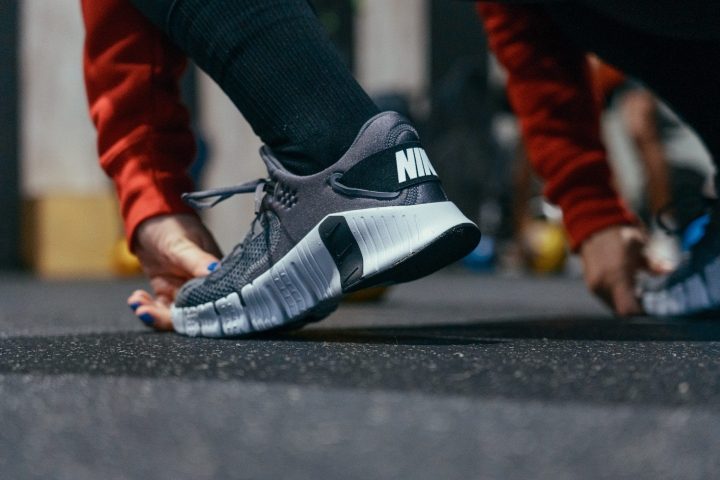
Cross-training functionality
Your HIIT workouts from day to day might look very different. On one day, you could be doing a Tabata sprint HIIT session on the treadmill, while the next day sees you alternating sets of burpees and then, on the third day doing a circuit weights session.
Within a single HIIT workout, you might also find yourself switching from running to plyometrics and weight training.
Your shoes need to be able to handle all of that variety. If you turn up to the gym in a pair of running shoes, you’re not going to have the stability you need when lifting, while a workout shoe is going to lack the cushioning required for those intense sprint sessions.
The high stacks and plush foams of running shoes are never a good idea for HIIT.
Most shoe manufacturers do not have a separate HIIT shoe category. But they will have a cross-training shoe category. Cross-training shoes are designed to meet that middle ground between a weight training shoe and a running shoe to meet the versatile needs of the average gymgoer.
To meet the diverse needs of the average gym goer a cross-training shoe is designed to promote:
- Versatility
- Responsiveness
- Stability
- Shock absorption
Shock absorbency
The intensity of HIIT training means that you’re putting a lot of stress on the lower body joints. Whether you are sprinting on a treadmill, doing box jumps, or repping out with burpees, your ankles, knees, and hips are going to take a beating. To minimise that impact you need a pair of shoes with a good level of shock absorbency.
A shoe with high shock absorbency will dissipate the amount of kinetic energy that transfers from the ground to your foot as you land. Shock-absorbing shoes typically have added foam, gel, or air bubbles in the areas where the highest impact occurs.
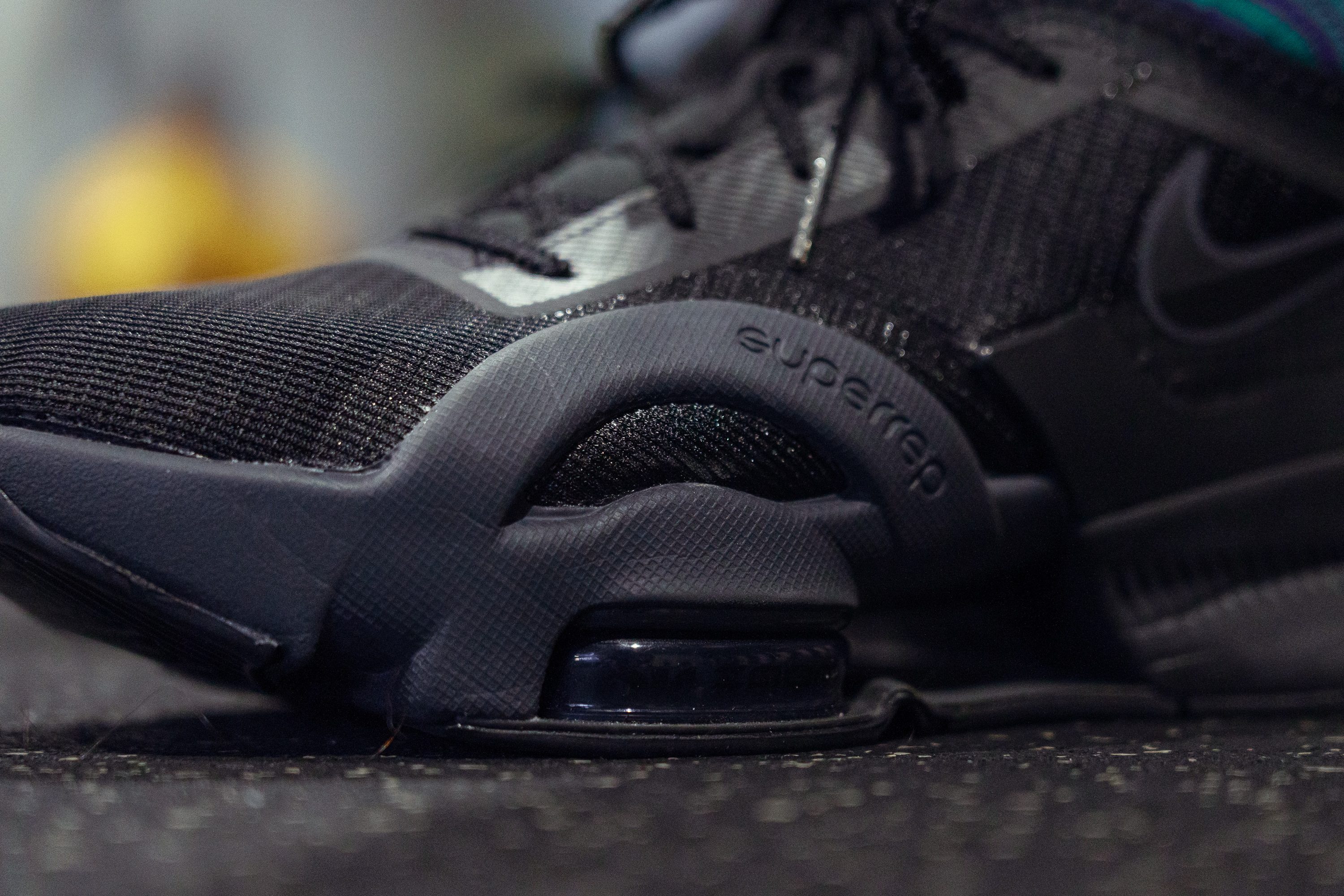
When it comes to shock absorbency, don’t go for a shoe with too much padding, especially in the heel. Some running shoes have so much heel padding that it feels as if you’re standing on a pillow. That will rob you of the stability you need and cause energy and power leaks that will prevent you from performing at your best.
Traction
Traction refers to the friction between the sole of your shoe and the ground that allows you to move with agility and prevents you from sliding or otherwise losing momentum.
If your HIIT workout involves jumping to the sides, such as when doing lateral jumping lunges, the traction of your sole is going to determine whether you perform the action fluidly or whether you end up sliding, and potentially twisting an ankle.
You want a shoe that has plenty of rubber traction in the forefoot and the heel. Basically, the more rubber underfoot, the greater your sole traction will be.
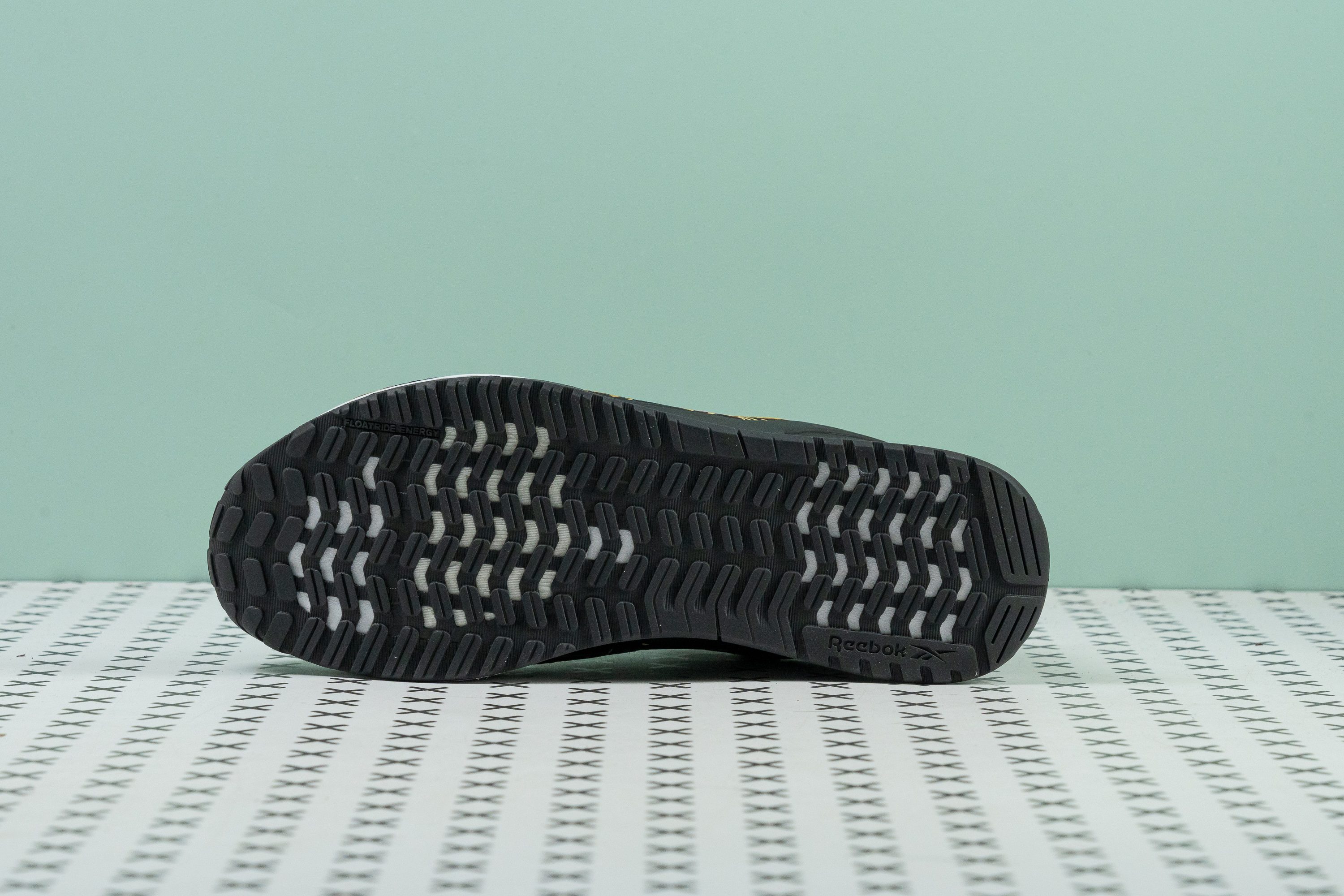
Stability
With HIIT training, you are going to be pushing yourself to the limit. When you’re working at that level, you can’t afford to be unstable on your feet. A key factor when it comes to stability is the amount of heel-to-toe drop.
Heel drop is the distance between the height of the heel and the height of the toe. The baseline heel drop would be if you were working out in bare feet. In that case, your heel drop would be zero as the heel and the toes are the same distance from the floor. Most running shoes have a heel drop of around 10 mm. This higher heel position allows for cushioning under the heel and encourages a heel-to-toe strike running action.

Weight training shoes, especially those designed for squats, have a much higher heel-to-toe drop than a running shoe. A typical weightlifting shoe drop is 17 mm. A higher heel supports an upright torso position, helps prevent back bending, and allows for a greater range of motion when squatting.
When you’re doing a HIIT workout, you do not want as much heel-to-toe drop as a weightlifting, or even a running, shoe. The forward angle will instantly detract from your stability. To ensure that your weight remains centred and your foot stable, look for a shoe with a heel-to-toe drop of around 4-6 mm (but no more than 8 mm).

Responsive midsole
A responsive midsole is a key requirement for a functional HIIT shoe. While you need a stable shoe, you also don’t want your foot to feel trapped and uncomfortable. The midsole, then, needs to be able to find a balance between stability and responsiveness.
Each manufacturer uses its own unique technology to provide midsole responsiveness. The vast majority of midsoles are constructed of some type of foam. The variable elements of foam are softness, responsiveness, durability, and lightness.
Breathable upper
By their very nature, HIIT workouts are short and intense. If you aren’t dripping buckets of sweat at the end of it, you’re probably not pushing hard enough. That means that your feet are going to get very hot, wet, and sticky at the end of a decent HIIT session. The more breathable and lightweight the upper material of the shoe is, the more comfortable your workout will be.
The more breathable the upper material of your shoe, the lighter the shoe will be. This creates less resistance and promotes workout efficiency. The best upper materials to look out for to promote breathability are mesh and knit.
What is HIIT and Why do it?
High Intensity Interval Training (HIIT) was ‘invented’ by Japanese Olympic Speed Skating Coach Azumi Tabata in the mid-2000s. Tabata had his athletes perform eight rounds of a workout that involved twenty seconds of sprint work followed by a ten-second recovery on a stationary cycle. When the athletes were tested after 8 weeks on this programme, it was found that all of their health parameters had significantly improved. Take a look at the key findings:
- Using HIIT workouts, athletes were able to burn more calories in 4 minutes than they had previously been doing in 30 minutes.
- Athletes were training close to their VO2 max during high-intensity periods.
- The participants increased their VO2 max, a great measure of cardiovascular fitness, by 28% - that is a huge increase, especially in top athletes.
- The HIIT workout plan turned on an ‘afterburn effect’, which increased athletes’ post-training metabolism. This allowed them to burn more calories for the next 24 hours.
- Overall aerobic fitness improved by 28%.

When these findings were published, trainers all over the world began to take notice. Over the last decade, there has been an explosion of interest in HIIT workout training. The promise of a more efficient and effective way to meet one’s fitness goals is very attractive.
Tabata’s original protocol has morphed in many directions. Yet, at its core, the HIIT programme involves alternating short periods of high-intensity, all-out exercise with short intervals of rest or active recovery.
Who is HIIT for?
HIIT will help anyone to lose body fat and improve their aerobic fitness. But that doesn’t mean that it should be used by everyone. As you may have already deduced, HIIT is hard work. It is an intense, demanding fitness protocol that is not suitable for some people.
If you have a history of cardiovascular issues, suffer from joint problems, or are prone to lower back pain, HIIT may be too intense for you. If you’re over 50, we suggest consulting your doctor before beginning a HIIT programme.
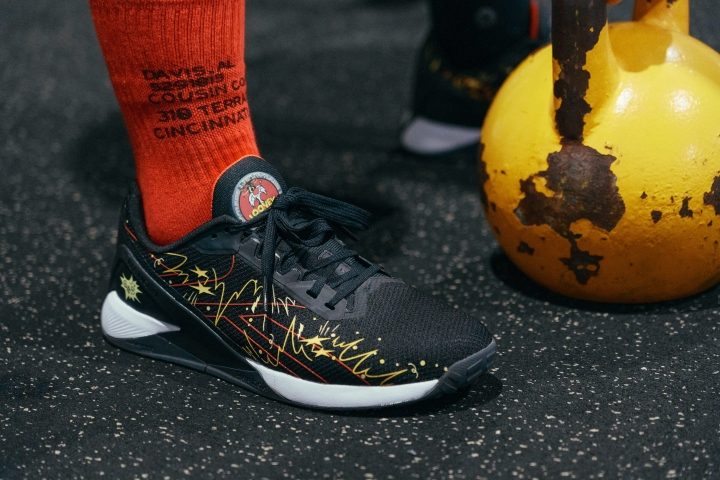
Frequently asked questions about HIIT shoes
Can I wear running shoes for my HIIT workouts?
Yes, you can do your HIIT workout in a running shoe, However, depending on the type of HIIT training you’re doing, it may not be a good idea. If you’re doing a high-intensity sprint workout, either on a treadmill or a running track, running shoes are the obvious choice. However, wearing running shoes for a HIIT session that involves lateral movement will not provide the agility and responsiveness that you need.
Running shoes may also provide too much cushioning so that you don’t get the stability that you need during your HIIT workout. Running shoes may also have a heel-to-toe drop that is too high for optimum foot stability and centre of gravity.
Cushioning on a running shoe
Cushioning on an HIIT shoe
Should I choose a cross-training shoe for my HIIT workouts?
Yes, you should choose a cross-training shoe for your HIIT workouts. Cross-training shoes are a hybrid of a running shoe and a weightlifting shoe, They are designed for general-purpose gym workouts that range from running to jumping and lifting weights.
In comparison to running shoes, cross trainers tend to have less cushioning in the heel and more in the midsole region. The toe box in a cross-training shoe is roomier than in a running shoe. Cross trainers also have a lower heel-to-toe drop than either a running or a weightlifting shoe.
| Average heel-to-toe drop | ||
| Road running shoes | Weightlifting shoes | Cross-training shoes |
| 9 mm | 17 mm | 5 mm |
Should HIIT shoes fit tightly?
Yes, you want a relatively tight-fitting HIIT shoe. A tight fit will prevent your heel lifting when you’re doing plyometric jumping movements. However, there should be a few millimetres of clearance between the tips of your toes and the upper material to allow for natural toe splay when you are pressing into the floor.
 Black Friday - best deals from 52 stores
Black Friday - best deals from 52 stores 